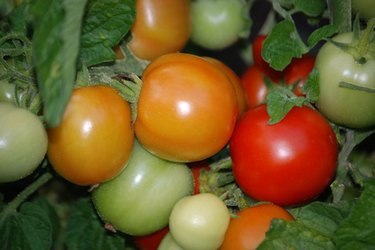
Home-grown tomatoes (Solanum lycopersicum) not only help you save money on groceries but they are also a delicious addition to salads, sandwiches and other recipes. If your tomatoes have white spots on the leaves or fruit, there are many potential causes, including sun scald, pest infestations, bacterial or viral diseases and poor growing conditions.
White Spots on Tomatoes
Video of the Day
What causes white patches on tomatoes? Sun scald is one possible reason for faded white patches on your home-grown tomatoes. This typically happens when the foliage is damaged or removed and can no longer protect the fruit from the heat. A home-grown tomato plant is more prone to sun scald during hot and dry conditions.
Video of the Day
If the white spots on the tomatoes are cloudy and irregularly shaped, this is likely caused by stink bugs. These pests feed on tomatoes by sucking out the juice of the fruit, leaving behind a discolored area. These bugs grow 1/4 to 1 inch long and have a shield-shaped body. Hand-pick the bugs to remove them and consider using an insecticide if there are too many to control by hand. Whitefly infestations, when severe enough, can also cause blotchy areas on the tomatoes.
White Spots on Tomato Leaves
If your tomato plant has white spots on the leaves, this may be a sign of disease. For example, septoria leafspot can cause white spots on the leaves with a black dot in the middle of the spot. These tomato marks start out black in color. Bacterial canker, on the other hand, causes small black spots with white halos on the tomatoes. Seedlings may have raised white spots on the leaves. The leaves eventually brown and wilt, and the plant may die.
Some viruses can also cause mottling and ring spots that are white or other colors. Fungal infections may also be to blame. Powdery mildew, for example, causes powdery white spots on the leaves of the plant.
You may not be able to cure tomato plants infected with bacterial or viral infections. Discard infected plants and disinfect any gardening tools you used on the plants. Rotate your crops so that you are not planting tomatoes or any other plant in the nightshade family, such as eggplant and peppers, in the same location as the infected plants in the next year. If available, purchase and plant disease-resistant tomato varieties. Make sure you space the tomatoes far enough apart to allow plenty of airflow.
Tomato Color Tips and Considerations
White tomatoes and green tomatoes with white stripes may be perfectly normal and fully ripe depending on the variety. If you are growing a variety that ripens to another color, such as red, orange or yellow, check for potassium deficiency in the soil, wet or compact soils and abnormally cold or warm temperatures that may be preventing fruit growth and ripening.
Yellow shoulder disorder can appear similar to sun scald or stink bug damage. The exact cause of this condition is unknown, but it is suspected to be caused by poor growing conditions, such as a high soil pH level, low organic matter in the soil or a low potassium level in the soil.